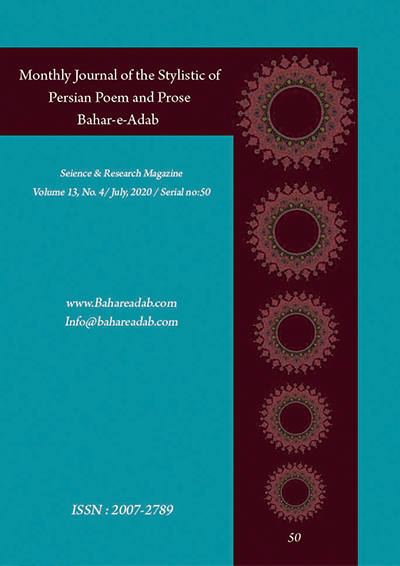- Count View : 496
- آدرس کوتاه شده مقاله: https://bahareadab.com/article_id/359
Journal of the stylistic of Persian poem and prose
volume Number 13،
number In Volume 4،
،
issue Number 50
The Function of divination in Khamse Nizami Ganjavi
Hojjat Kojani Hesari, Mohammad Reza Pashaei(Author in Charge)
Abstract
Divination and humorous people and events have been the commonplace traditions of old societies. Fooling was a kind of prediction of future events, which in many cases inspired the savvy of his owner or plans to prevent possible losses. It is widely mentioned in various historical, literary and scientific works of the early centuries of the Persian language after Islam. Nizami In the sixth century AH, referred to this belief and commonplace in society among his five poems. This research was conducted with the aim of investigating the performance of Ganjavi"s military khmesa to showcase the beliefs and types of foolishness in the military system and to introduce a variety of tales, interpretations and falsifications in the works. The present study is conducted in a librarian way, with the extraction of various types of horoscope from the works of this poet and their classification by reviewing the articles and the corresponding books. The results show that, given the abundance of military references, the poet himself does not have any opinion on this issue; however, he has addressed the situation of society. In his works, this work is common in two ways, sometimes in the form of good and evil, sometimes in the form of words interpreted, drawn and walled.
Keyword
Nizami Ganjavi
, five treasure
, divination
, omen
, interpretation
- Borhan, Mohammad Hossein Ibn Khalaf (2005), Borhan Persian Culture, Tehran: Baran Andisheh Publishing
- Balami, Abu Ali Mohammad Ibn Mohammad (1341), History of Balami, edited by Mohammad Tafi Bahar, Tehran: General Directorate of Writing and Ministry
- Bahar, Mehrdad (1990), A Research in Iranian Mythology, Tehran: Agah
- Biruni, Abu Rihan Mohammad Ibn Ahmad (unpublished) Al-Tafhim Early Sana'a Al-Tanjim, by Homayesh, Tehran: National Works Association
- Hafez Shirazi, Shamsuddin Mohammad (1990), Divan, edited by Qasem Ghani, Tehran: Zavar
- Hakemi, A (2003), A review of the history of divination and its reflection in some histories and texts of Persian literature, Journal of the Faculty of Literature, University of Tehran, p.17
- Dashti, Seyed Mostafa (1371), Maaref va Maareef, Qom: Danesh
- Khayyam Neyshabouri, Omar Ibn Ibrahim (1962), Nowruznameh, by Ali Hosouri, Tehran: Tahoori
- Dehkhoda, Ali Akbar (2004), Proverbs and Verdicts, Tehran: Amirkabir
- ............ (1998), Dictionary, Tehran: University of Tehran
- Damavandi, Mojtaba (2005), Magic in Tribes, Religions and Its Reflection in Persian Literature, Semnan: Abarkh
- Zarrinkoob, Abdolhossein (1372), Pirganjeh in Search of Nowhere, Tehran: Sokhan
- ............ (2004), Notes and Thoughts, Tehran: Sokhan
- Zener, R, C (2005), Zarwan or Zoroastrian Architecture, translated by Timur Ghaderi, Tehran: Amirkabir
- Saeidian, Abdolhossein (1996), People of Iran, Tehran: Elm va Zendegi
- Shamloo, Ahmad (1998), Alley Book, Tehran: Maziar
- Shamisa, Sirus (1998), Farhang-e Asharat, Tehran: Ferdows
- Attar Neyshabouri, Farid al-Din (1998), Mantiq al-Tair, by Sadegh Goharin, Tehran:Elmi va Farhangi
- Kajani Hesari, H (2006), Astrology and working in astrology in military works, Hafez Monthly, No. 30, page 63
- Xenophon (1397), The Campaign of Cyrus, translated by Vahid Mazandarani, Tehran: Book World
- Mirnia, Seyed Ali (1999), People's Culture (Iranian Folklore), Tehran: Parsa
- Hedayat, Sadegh (2536), Nirangistan, Tehran: Javidan
- Jung, Carl (1998), Man and His Symbols, translated by Mahmoud Soltanieh, Tehran: Jam

